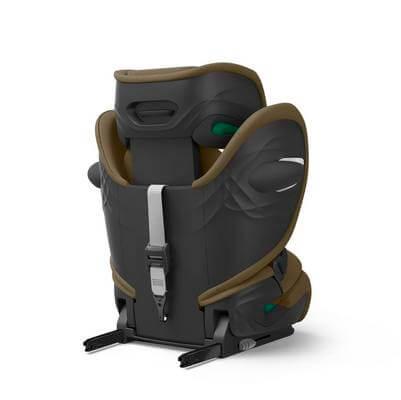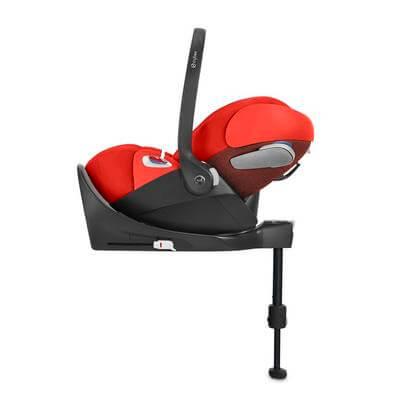Cybex Car Seat Safety Guide
Giving you peace of mind that your little one is safely secured, child car seats are essential when driving with children and understanding how to use one properly is important.
To help, CYBEX - a global car seat brand renowned for its safety and award-winning car seats, luxurious pushchairs, and baby carriers - have created an essential guide to child car seat safety.
How to fit a child car seat
For a car seat to work effectively and provide maximum protection to your child, it’s important to ensure it’s fitted into your car correctly and that your child is correctly secured. When fitting a car seat, you need to consider three key things:
Child car seat positioning
Before securing a child seat in a car, it needs to be positioned correctly.
Ensure that the majority of the base or ISOFIX base of the child seat is flat on the seat of the car with hardly any forwards or sideways movement. This should be evenly positioned and shouldn’t be lifting at any point.
For most car seats, the headrest needs to be removed or moved to the highest position so that it doesn’t come into contact with the seat. Others require the headrest to be attached so make sure you check through the manual for your car seat.
Installing a child car seat
Once you’re happy that the car seat is in the right position, it needs to be securely fitted.
- ISOFIX: If your seat uses ISOFIX connect technology, check the
indicators on either side of the seat. The indicators are red when the seat is either not in the
car, or
when it’s not connected properly. The indicators turn green when the ISOFIX locks into place.
- Load leg: If your seat uses a load leg design, check that it’s sitting evenly on the floor and that it isn’t lifting the seat too far up - many load legs have indicators to show the load leg is correctly placed. If possible, don’t store anything in the footwell as it may impact the effectiveness of the load leg if the car is in a collision.
- Top tether: For seats with a top tether, the tether needs to
go
over the back of the seat and clip into the dedicated mounting point.
Installing with an adult seatbelt
Some car seats are secured using the seatbelt. The seatbelt must be tightly fitted ensuring that the seat doesn’t move. On seats that are rear facing the seat belt guides are blue and on forward-facing seats the guides are red or green.
When securing an infant carrier, you can check that the seatbelt is tight enough by pushing down on the area where your child’s head would be - the seat should not move. Also, check that the seatbelt remains completely untwisted all around the seat.
For forward-facing car seats such as the Cybex Pallas M-Fix SL, pull on the seatbelt to check that it still flows through the belt guides correctly. When the seatbelt is clicked in, pull on the belt by your child’s shoulder in order to tighten the lap belt ensuring there is no slack. Finally, pass the adult seat belt through the shoulder belt guides.
Securing a child in a car seat
Once your car seat is correctly installed in the car, it’s time to secure your child in it. Making sure your child is safely secured is important so that they receive the maximum protection offered by the seat. Here’s what you’ll need to consider:
- Is your carrying handle in the correct
position for driving?
When using an infant carrier, the carrying handle will need to be in a specific position when it is placed in the car - this is normally upright or fully back so that it can provide additional 360-degree protection if your vehicle turns over due to a crash. Check your instruction manual so you know exactly where yours should be. - Is the harness secure?
Always ensure the harness is properly secured. Start by making sure the shoulder pads of your child’s harness are as level with their shoulders as possible. For rear-facing seats, the shoulder pads should drop down no more than 2cm, and in a forward-facing seat, rise by no more than 2cm. This offers additional comfort for your little one. For older children, check that the seatbelt is across their shoulders and hips. The seatbelt should sit on an older child’s shoulder and shouldn’t cut into their neck or sit lower down on their arm. Make sure the lap part of the seatbelt sits across their hips too.
TOP TIP: Don’t forget the pinch test! If you can pinch the slack of the harness between your fingers, then the harness is too loose and should be pulled tighter. A correctly fitting harness will allow two fingers between the child’s collarbone and the harness. - Is your child wearing the right
clothing?
This is one you’ll need to plan ahead for! During the winter, babies and children need to be kept warm but in car seats thick clothing prevents the harness or impact shield from lying tight against their body. Only a correctly adjusted restraint system can offer maximum protection. For this reason, remember to check what your child is wearing - they should wear thin, well-fitting clothing. Thick clothing such as winter jackets, snow suits, and clothing with hoods (hoodies, teddy suits, etc.) should be avoided. Once your child has been positioned in the seat, he or she can be covered with a blanket or footmuff for warmth.
When to change a car seat?
Depending on what car seat you have, there may come a time when you need to upgrade your car seat or adjust your child’s current seat to their needs. But when does a child car seat need replacing?
Your first step should be to check the seat for any signs of damage or wear. Your seat’s manual will provide more detailed points on what you should look out for here.
Not all seats are designed to protect your child from birth to their early teens and there will come a time when your child has outgrown their seat. To check this, look at the position of your child’s head and ask yourself whether it has reached the top of the seat when the headrest is in the highest position? If so, there’s a good chance your child has outgrown their seat and it’s time to invest in a new one.
How to pick the correct child car seat?
Whatever age or size, CYBEX has a car seat for every child. When it’s time to upgrade, use our handy guide below to find the perfect new car seat. You can discover more about car seat groups here.
CYBEX infant car seats
- Age: birth up to approximately 18-24 months
- Height and weight: suitable for children measuring between 45cm and 87cm, and weighing up to 13kg
- Group 0+
CYBEX toddler car seats
- Age: birth up to approximately 4 years
- Height and weight: suitable for children measuring between 45cm and 105cm, and weighing up to 18kg
- Group 0+/1
CYBEX 2-in-1 car seats
- Age: from approximately 9 months up to 12 years
- Height and weight: suitable for children weighing between 9kg and 36kg
- Group 1/2/3
You can discover more about CYBEX and explore their full range of car seats here.
For more child car seat guidance, head over to our advice
and
help guides.
Introducing the Halfords Motoring Club
Don’t miss out! Join the Halfords Motoring Club today to access a range of amazing benefits and discounts that are designed to keep you moving, keep you safe and keep you saving.
IIt’s free to join and you’ll receive money off your MOT, a free car health check and a welcome voucher that can be spent on any Halfords product or service.
Or choose our Premium membership for a monthly fee of £5.49 (£65.88) or £54 annually to unlock exclusive member pricing on all motoring products and services online and across our stores, garages and Halfords Mobile Experts, as well as a variety of other benefits that will help you to keep moving for less.
With so much to enjoy, this is too good an opportunity to miss!
Join the Halfords Motoring Club today at www.halfords.com/motoring-club.
Join the Halfords Motoring Club



